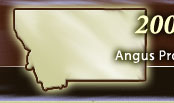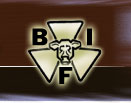|
Tours
A Montana Seedstock Tour and a Montana Commercial Tour are scheduled to take place Saturday, July 9. Both tours will leave the hotel at approximately 7:30 a.m. and will have lunch, sponsored by Certified Hereford Beef, at the USDA-ARS Livestock and Range Research Laboratory at Miles City. The seedstock tour is scheduled to return to the hotel by 6 p.m.; the commercial tour will return by 7 p.m.
STOP 1: Redland Red Angus, Hysham
Redland Red Angus is located 75 miles east of Billings and believes in performance breeding for the future. The operation has two annual sales at its sale facility — a female sale (both registered and commercial) the first Saturday in December and a spring yearling bull sale in April. Semen, embryos and animals by private treaty are available year-round.
STOP 2: Larsen Ranch Angus, Rosebud
Larsen Ranch Angus started breeding registered Angus cattle in 1949. Cattle were sold private treaty until 1974, when it began its annual sale, scheduled for the fourth Monday in March each year. The operation currently manages about 200 registered Angus cows and 500 purebred black Angus commercial cows. Selling 90% of its cattle by the pound ensures the operation is producing cattle to serve the market of today, while keeping customers profitable.
The herd is built mainly of proven herd sires such as Schearbrook Shoshone, QAS Traveler, 1148 Traveler, Rito 054, AAR New Trend and Rito 2100.
Larsen Ranch Angus, located in southeastern Montana, is owned and operated by Jim and Carin Larsen, Lafe and Wendy Warren, and Tyler Larsen. The program has always been to produce the most efficient cow possible. This means a cow that doesn’t need any extra help to bring in a big calf every year.
For more information visit www.larsenranchangus.com.
STOP 3 (Lunch): USDA-ARS Fort Keogh Livestock and Range Research Laboratory, Miles City
The Custer Massacre led Congress to establish Fort Keogh as an Army cavalry post July 22, 1876. Fort Keogh was named after Captain Myles Keogh, an adjutant to General George Custer, who was killed in the Battle of the Little Big Horn June 25, 1876. Establishment and early development of Fort Keogh was under the direction of General Nelson A. Miles, for whom Miles City is named. Remains of the original Fort include the parade ground, a wagon shed built in 1883, the flagpole erected in 1887 and seven other structures built prior to 1924.
By an act of Congress in 1924, jurisdiction of the Fort Keogh Military Reservation was transferred to the U.S. Department of Agriculture for experiments in stock raising and growing of forage crops. Today, the research program focuses on improving efficiency of beef cattle production for rangeland in the Northern Great Plains. These rangelands, some 150 million acres in Montana, North Dakota, South Dakota and Wyoming, are both ecologically fragile and vital to the economic well-being of the region. The work involves studies in genetics, reproductive physiology, nutrition and growth of beef cattle, and in range pasture development, improvement and management. This mix of disciplines provides an effective and integrated attack on basic and applied problems related to efficient and sustainable use of rangeland resources for livestock production. Emphasis is on problem-solving, basic research to meet the immediate and future needs of farmers and ranchers in the region and nation. Funding for research is provided by appropriation through USDA-ARS. Cooperation with Montana Agricultural Experiment Station provides livestock and labor resources to the laboratory. No appropriated funds are received from the State of Montana.
STOP 4: Vermilion Ranch/Tomahawk Land and Cattle, Billings
STOP 1: Fred Wacker
STOP 2 (Lunch): USDA-ARS Fort Keogh Livestock and Range Research Laboratory, Miles City
The Custer Massacre led Congress to establish Fort Keogh as an Army cavalry post July 22, 1876. Fort Keogh was named after Captain Myles Keogh, an adjutant to General George Custer, who was killed in the Battle of the Little Big Horn June 25, 1876. Establishment and early development of Fort Keogh was under the direction of General Nelson A. Miles, for whom Miles City is named. Remains of the original Fort include the parade ground, a wagon shed built in 1883, the flagpole erected in 1887 and seven other structures built prior to 1924.
By an act of Congress in 1924, jurisdiction of the Fort Keogh Military Reservation was transferred to the U.S. Department of Agriculture for experiments in stock raising and growing of forage crops. Today, the research program focuses on improving efficiency of beef cattle production for rangeland in the Northern Great Plains. These rangelands, some 150 million acres in Montana, North Dakota, South Dakota and Wyoming, are both ecologically fragile and vital to the economic well-being of the region. The work involves studies in genetics, reproductive physiology, nutrition and growth of beef cattle, and in range pasture development, improvement and management. This mix of disciplines provides an effective and integrated attack on basic and applied problems related to efficient and sustainable use of rangeland resources for livestock production. Emphasis is on problem-solving, basic research to meet the immediate and future needs of farmers and ranchers in the region and nation. Funding for research is provided by appropriation through USDA-ARS. Cooperation with Montana Agricultural Experiment Station provides livestock and labor resources to the laboratory. No appropriated funds are received from the State of Montana.
STOP 3: Kite Cattle Co., Roundup
STOP 4: Jersey Lilly Saloon & Eatery, Ingomar
Come to Ingomar and touch a piece of the past at the historic Jersey Lilly Saloon & Eatery. The Jersey Lilly is listed on the National Register of Historic Places. Tour attendees will enjoy this stop that gives them a glimpse into the Old West. A must-see for any visitor to Montana, the Jersey Lilly is truly a one-of-a-kind piece of Old West history. You can find more information on the Jersey Lilly at its Web site, www.thejerseylilly.com.
STOP 5: Dover Ranch
The Dover Ranch was founded in 1881 when John Dover homesteaded on an island in the Yellowstone River, several miles below Billings. In 1904 John’s wife, Mary, homesteaded other area land, which became the present site of the Dover.
Shorthorn cattle were purchased from a neighbor in the 1880s and have been run continuously on the ranch for more than 100 years. The present operators grew up with Shorthorn cattle and make their living from them. In doing so, they have developed a very strong idea of the breed’s purpose, abilities and potential.
Dover Ranch operates on 12,000 acres; 1,500 acres is seeded with crested wheatgrass and divided into 20 separate breeding pastures. Another 1,000 acres produce hay and grain for cattle. The remainder is in native pastures. Fifteen miles of pipeline supply water to all pastures for stock.
After being reduced by years of drought, the cow herd is at 300 head. First-calf heifers are artificially inseminated (AIed) to light-birth-weight Red Angus bulls to start calving Feb. 1, three weeks ahead of the cow herd. Most of the Shorthorn bulls used on the cow herd are raised at Dover Ranch.
A comprehensive preconditioning program is followed prior to shipping weaned calves. Top bull calves and heifers are fed a growing ration through the winter for within-herd replacements and outside sales.
Selection of cattle using objective data, rangeland improvements and water development have all been major contributions to the success and longevity of Dover Ranch.
|






